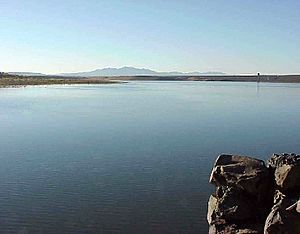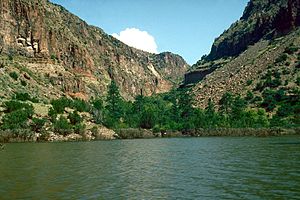Cochiti Dam facts for kids
Quick facts for kids Cochiti Dam |
|
|---|---|

Cochiti Dam from lake side
|
|
| Official name | Cochiti Dam |
| Location | Cochiti Pueblo, Sandoval County, New Mexico, USA |
| Coordinates | ACoordinates: Unknown argument format |
| Construction began | 1965 |
| Opening date | 1973 |
| Operator(s) | United States Army Corps of Engineers |
| Dam and spillways | |
| Impounds | Rio Grande, Santa Fe River |
| Height | 251 ft (76.5 m) |
| Length | 29,040 ft (8,852 m) |
| Width (base) | 1,760 ft (536.4 m) |
| Reservoir | |
| Creates | Cochiti Lake |
| Total capacity | 718,019 acre-feet (885,663,000 m3) |
| Active capacity | 49,359 acre-feet (60,883,000 m3) |
The Cochiti Dam is a huge earthen wall built on the Rio Grande river in New Mexico, USA. It's about 50 miles (80 km) north of Albuquerque, New Mexico. This dam also holds back water from the Santa Fe River.
Cochiti Dam is one of the biggest dams in the world made from earth. It's also one of the top ten largest earthen dams in the United States. The dam is part of a group of four projects managed by the United States Army Corps of Engineers. These projects help control floods and sediment (dirt and sand) in the Rio Grande river system.
Contents
What Cochiti Dam Does
The main job of Cochiti Dam is to stop floods. It helps control the powerful rush of water that can happen after heavy rains or snowmelt. The dam also helps create fun places for people to visit and homes for wildlife.
When a lot of water flows into the lake, the dam holds it back. This stops flooding downstream. Once the river below the dam can safely handle more water, the stored water is slowly released. This careful control helps protect communities and farms.
Cochiti Dam also marks the start of an important water management area. This area, called the Middle Rio Grande Conservancy District, helps manage water for farming. The dam controls water from a very large area, covering about 11,695 square miles (30,300 km²).
Building the Dam
The idea for Cochiti Dam was approved in 1960. It was built to help prevent floods. Later, in 1964, the plan was updated to also create places for fish, wildlife, and recreation. Water from another project, the San Juan–Chama Project, was used to fill the lake and replace water lost to evaporation.
Construction of the dam started in 1965. By 1973, water began to fill the area behind the dam, creating Cochiti Lake. Before the lake was filled, experts studied the land for important historical sites. The new dam took over the job of an older dam that was used for irrigation.
The Cochiti people, who are Native Americans living nearby, were against building the dam. They lost a lot of their farming land when the lake was created. They even filed a lawsuit about it and won. In 2001, the Army Corps of Engineers said they were sorry to the Cochiti people for what happened.
Cochiti Lake Fun
Cochiti Lake has a permanent pool of water that helps trap sediment. This means dirt and sand don't flow downstream as much. This permanent lake was created and is kept full using water from the San Juan-Chama Project. The rest of the lake's space is saved for flood control.
There are two public areas where people can enjoy the lake. One is the Cochiti Recreation Area on the west side. The other is the Tetilla Peak Recreation Area on the east. Other lands around the lake belong to the Pueblo de Cochiti Indian Reservation and are not open to the public.
You can go fishing in Cochiti Lake. Some of the fish you might catch include smallmouth bass and northern pike. It's a "no-wake" lake, which means boats must go slowly, like trolling speed. This keeps the water calm and safe for everyone.
The Pueblo of Cochiti and the Dam
The Pueblo of Cochiti is an ancient community of Native Americans. They are also known as Ko-Tyit and speak the Keresan language. Their history in this region goes back thousands of years. They have lived on and cared for this land for a very long time.
The Pueblo of Cochiti people faced many challenges throughout history. They were controlled by the Spanish and later dealt with issues like slavery and bans on their cultural practices. In 1680, they took part in the Pueblo Revolt and moved to where Cochiti, New Mexico, is today.
Today, the Pueblo of Cochiti lives on about 50,000 acres (20,234 hectares) of land near Albuquerque. Their population is under 2,000 people. They are famous for making beautiful jewelry, pottery, and drums.
Cochiti Lake is one of the largest human-made lakes in the United States. The U.S. Army Corps of Engineers built and manages both the lake and the dam. About 11,000 acres (4,450 hectares) of the Cochiti Pueblo's ancestral lands are now covered by the dam and lake.
Indigenous (Native) peoples have a special connection to the environment. They often see the land as sacred and use it for cultural and spiritual practices. Many indigenous groups work to protect the land and its biodiversity.
The Cochiti Dam changed the way of life for the Pueblo of Cochiti forever. When the dam was built, water seeped into their lands, causing floods. This meant the Cochiti people lost their traditional farming way of life. Farming was a big part of their economy and culture.
A sacred place for the Pueblo of Cochiti, called The Whirlpool Rock, was destroyed when the dam was built. This happened even though the Army Corps of Engineers had promised it wouldn't. This loss affected the religious practices of the Cochiti and nearby Pueblos.
Regis Pecos, a member of the Traditional Tribal Council, said that since the lake and dam were created, the Cochiti Pueblo has been fighting for their survival. They want to keep their culture, politics, economy, and environment strong. Their mission is to overcome challenges and bring back their way of life. They also want to manage their own lands and not be controlled by the government.
The Pueblo of Cochiti strongly opposed the dam in the 1960s. However, their opposition became weaker in the 1970s. Some people believe the U.S. government used manipulation to get the Cochiti people to agree to the dam project. They told Cochiti soldiers returning from wars that they understood how things worked better than those who stayed home. The Cochiti people lost their sacred and farming lands to the U.S. government. After World War II, they had to find new jobs outside their reservation to survive.
Efforts to Reclaim Land
The Pueblo of Cochiti has filed many reports and lawsuits against the U.S. Army Corps of Engineers. In 1976, they reported that the dam caused their farmland to flood. Years later, a drainage system was installed, but it didn't work well. In 1988, the Army Corps of Engineers finally accepted responsibility for the farming problems. Studies showed that much of the Cochiti's irrigated land was no longer good for farming. In 1990, a settlement was reached, and the U.S. government provided $4.5 million for drainage system maintenance.
The Pueblo of Cochiti also sued the Army Corps of Engineers for destroying their sacred lands. Their native religion was not protected under certain laws, which made it hard to protect the land. However, in the 1980s, Congressman Bill Richardson helped the Pueblo of Cochiti. He worked with them to get back 25,000 acres (10,117 hectares) of their ancestral lands. Congressman Richardson was seen as a "light" during a difficult time for the Cochiti reservation.
Organizations like Cultural Survival support Indigenous Peoples' rights. They say the Pueblo of Cochiti has been working with a difficult government agency, the U.S. Army Corps of Engineers.
In 2016, the Cochiti people proposed a bill called S. 2643, or The Pueblo Of Cochiti Self Governance Act. This act would let the Pueblo of Cochiti take over the management of the Cochiti Dam. This would allow them to restore their ancestral lands. The act would also help them get back lands known as the Cañada de Cochiti (Cochiti Canyon) without having to pay for them. However, this bill has not yet passed.
After the Las Conchas fire in New Mexico, which damaged surrounding lands, the Pueblo of Cochiti made an agreement with the state of New Mexico. If the Pueblo buys land of equal value, New Mexico would transfer ownership of the Cañada de Cochiti to them. This would give the state more land that makes money, and the Pueblo would get back land for cultural use. However, the Cañada de Cochiti was valued at about $5 million, making it very hard for the Pueblo of Cochiti to buy it. For this agreement to work, the U.S. Congress needs to approve it.
See also
- Project Travois



